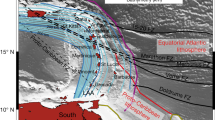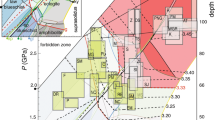Abstract
The water released from descending oceanic lithosphere is thought to have an important role in subduction-zone magmatism, as this water might trigger partial melting of the mantle wedge above the subducting plate1,2,3,4,5,6,7,8. If, however, there is incomplete wetting of mineral grain boundaries in the mantle (that is, the dihedral angle9 at the triple junctions between grains is more than 60°), then the water would not form an interconnected network and might instead be trapped as interstitial fluid in the mantle peridotite. The water would then be transported to deeper parts of the mantle rather than triggering partial melting. Here we use dihedral-angle data to estimate the connectivity of an aqueous fluid phase in a model upper-mantle mineral assemblage (forsterite) at pressures from 3 to 5 GPa (corresponding to depths of ∼80–150 km). By combining these data with previous results10,11, we find that the dihedral angle is greater than 60° at low pressure and temperature (<1,000 °C at 2 GPa and <800 °C at 4 GPa) and lower than 60° at higher pressures and temperatures, suggesting that wetting is incomplete below these conditions. This indicates that the connectivity of water in hydrous upper-mantle peridotite at convergent plate boundaries might control the position of the volcanic front in island arcs.
This is a preview of subscription content, access via your institution
Access options
Subscribe to this journal
Receive 51 print issues and online access
$199.00 per year
only $3.90 per issue
Buy this article
- Purchase on Springer Link
- Instant access to full article PDF
Prices may be subject to local taxes which are calculated during checkout





Similar content being viewed by others
References
McBirney,A. R. Compositional variations in Cenozoic calc-alkaline suites of Central America. Proc. Andesite Conf., Dept. Geol. Mineral. Industr., Oregon, 185–189 (1969).
Kushiro,I. On the lateral variations in chemical composition and volume of Quaternary volcanic rocks across Japanese arcs. J. Volcanol. Geotherm. Res. 18, 435–447 (1983).
Sakuyama,M. & Nesbitt,R. W. Geochemistry of the Quaternary volcanic rocks of the Northeast Japan arc. J. Volcanol. Geotherm. Res. 29, 413–450 (1986).
Tatsumi,Y. Migration of fluid phases and genesis of basalt magmas in subduction zones. J. Geophys. Res. 94, 4697–4707 (1989).
Davies,J. H. & Stevenson,D. J. Physical model of source region of subduction zone volcanics. J. Geophys. Res. 97, 2037–2070 (1992).
Tatsumi,Y. & Eggins,S. Subduction Zone Magmatism (Blackwell, Cambridge, 1995).
Iwamori,H. Transportation of H2O and melting in subduction zones. Earth Planet. Sci. Lett. 160, 65–80 (1998).
Schmidt,M. W. & Poli,S. Experimentally based water budgets for dehydrating slabs and consequences for arc magma generation. Earth Planet. Sci. Lett. 163, 361–379 (1998).
Smith,C. S. Grains, phases, and interfaces: An introduction of microstructure. Trans. Metall. Soc. AIME 175, 15–51 (1948).
Watson,E. B., Brenan,J. M. & Baker,D. R. in Continental Mantle (ed. Menzies, M.) 111–125 (Oxford Univ. Press, Oxford, 1991).
Mibe,K., Fujii,T. & Yasuda,A. Connectivity of aqueous fluid in the Earth’s upper mantle. Geophys. Res. Lett. 25, 1233–1236 (1998).
Shannon,M. C. & Agee,C. B. High pressure constraints on percolative core formation. Geophys. Res. Lett. 23, 2717–2720 (1996).
Jurewicz,S. R. & Jurewicz,A. J. G. Distribution of apparent angles on random sections with emphasis on dihedral angle measurements. J. Geophys. Res. 91, 9277–9282 (1986).
Faul,U. H. Permeability of partially molten upper mantle rocks from experiments and percolation theory. J. Geophys. Res. 102, 10299–10311 (1997).
Cmíral,M., FitzGerald,J. D., Faul,U. H. & Green,D. H. A close look at dihedral angles and melt geometry in olivine-basalt aggregates: A TEM study. Contrib. Mineral. Petrol. 130, 336–345 (1998).
Fujii,T., Mibe,K. & Yasuda,A. Composition of fluid coexisting with olivine and pyroxene at high pressure: The role of water on the differentiation of the mantle (abstr.). Misasa Seminar on Evolutionary Processes of Earth and Planetary Materials, 37–38 (1996).
Mibe,K., Fujii,T. & Yasuda,A. Compositions of aqueous fluid coexisting with mantle minerals at high pressures: The role of water on the differentiation of the mantle (abstr.). Terra Nova 9, (Suppl.), 483 (1997).
Stalder,R., Foley,S. F., Brey,G. P. & Horn,I. Mineral-aqueous fluid partitioning of trace elements at 900–1200 °C and 3.0–5.7 GPa: New experimental data for garnet, clinopyroxene, and rutile, and implications for mantle metasomatism. Geochim. Cosmochim. Acta 62, 1781–1801 (1998).
Nakamura,Y. & Kushiro,I. Composition of the gas phase in Mg2SiO4-SiO2-H2O at 15 kbar. Year Book Carnegie Inst. Washington 73, 255–258 (1974).
Furukawa,Y. Magmatic processes under arcs and formation of the volcanic front. J. Geophys. Res. 98, 8309–8319 (1993).
Peacock,S. M. Large-scale hydration of the lithosphere above subducting slabs. Chem. Geol. 108, 49–59 (1993).
Sugimura,A. Zonal arrangement of some geophysical and petrological features in Japan and its environs. J. Fac. Sci. Univ. Tokyo, Sec. II 12, 133–153 (1960).
Gill,J. Orogenic Andesite and Plate Tectonics (Springer, New York, 1981).
Kawamoto,T. & Holloway,J. R. Melting temperature and partial melt chemistry of H2O-saturated mantle peridotite to 11 gigapascals. Science 276, 240–243 (1997).
Sakuyama,M. Petrology of arc volcanic rocks and their origin by mantle diapirs. J. Volcanol. Geotherm. Res. 18, 297–320 (1983).
Ishikawa,T. & Nakamura,E. Origin of the slab component in arc lavas from across-arc variation of B and Pb isotopes. Nature 370, 205–208 (1994).
Ono,S. Stability limits of hydrous minerals in sediment and mid-ocean ridge basalt compositions: Implications for water transport in subduction zones. J. Geophys. Res. 103, 18253–18267 (1998).
Wilks,S. S. Mathematical Statistics (Wiley, New York, 1962).
Stickels,C. A. & Hucke,E. E. Measurement of dihedral angles. Trans. Metall. Soc. AIME 230, 795–801 (1964).
Watson,E. B. & Lupulescu,A. Aqueous fluid connectivity and chemical transport in clinopyroxene-rich rocks. Earth Planet. Sci. Lett. 117, 279–294 (1993).
Davies,J. H. The role of hydraulic fractures and intermediate-depth earthquakes in generating subduction-zone magmatism. Nature 398, 142–145 (1999).
Acknowledgements
We thank M. Toriumi, S.-I. Karato, S. Ono, T. Hanyu, K. Kaneko, Y. Takei, D. Yamazaki and T. Yoshino for discussions. We also thank B. O. Mysen, C. R. Bina and J. M. Brenan for his helpful reviews. This manuscript was prepared with support from the Research Fellowships of the Japan Society for the Promotion of Science for Young Scientists.
Author information
Authors and Affiliations
Corresponding author
Rights and permissions
About this article
Cite this article
Mibe, K., Fujii, T. & Yasuda, A. Control of the location of the volcanic front in island arcs by aqueous fluid connectivity in the mantle wedge. Nature 401, 259–262 (1999). https://doi.org/10.1038/45762
Received:
Accepted:
Issue Date:
DOI: https://doi.org/10.1038/45762
This article is cited by
-
Fluids and physicochemical properties and processes in the Earth
Progress in Earth and Planetary Science (2022)
-
Ammonium Impacts on Vibrations of Hydroxyl and Lattice of Phengite at High Temperature and High Pressure
Journal of Earth Science (2021)
-
Saline aqueous fluid circulation in mantle wedge inferred from olivine wetting properties
Nature Communications (2019)
-
Semi-brittle behavior of wet olivine aggregates: the role of aqueous fluid in faulting at upper mantle pressures
Contributions to Mineralogy and Petrology (2018)
-
Constraints from the dehydration of antigorite on high-conductivity anomalies in subduction zones
Scientific Reports (2017)
Comments
By submitting a comment you agree to abide by our Terms and Community Guidelines. If you find something abusive or that does not comply with our terms or guidelines please flag it as inappropriate.



